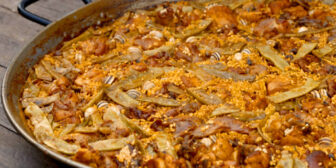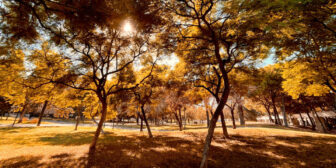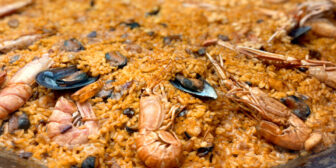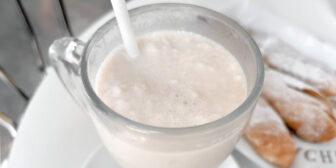Most people visiting Spain share a common goal – to savor paella in its country of origin. Some have a good idea of what paella is, but there are plenty others who are shocked to discover that paella is not exactly what they thought it was.
So what is paella? What ingredients go into it? Where exactly it is from? And why is there so much confusion surrounding it?
What seems like a simple question, “What is paella?” turns out to be a controversial topic that not many experts and cooks agree on. Ask ten Spaniards “What is paella?” and you might get ten different answers. You might also be surprised just how passionate they feel about this dish.
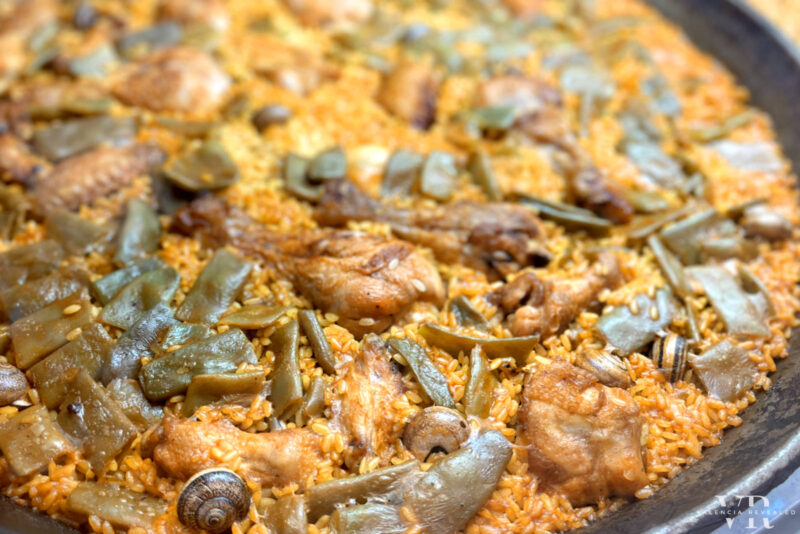
In This Article
What is paella?
Paella (pronounced “pah-EH-yah“) is a traditional Spanish dish hailing from the Valencia region, on the Mediterranean coast of Spain. Paella is typically made with a variety of ingredients such as rice, saffron, vegetables, meat, and/or seafood. The result is a flavorful dry rice dish with a distinct golden color.
Where does paella come from?
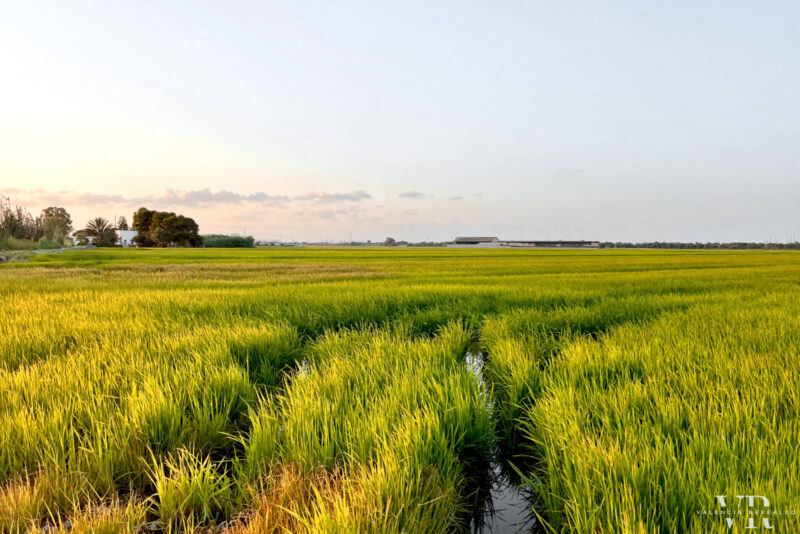
For millions of people around the world, paella is almost synonymous with Spanish cuisine. Given its popularity, many assume paella is Spain’s national dish.
However, an interesting fact about Spain is that officially, Spain doesn’t have a national dish. And even if it had, the honor would probably go to the humble tortilla de patatas (Spanish potato omelet).
Contrary to popular belief, paella is not as universally Spanish as you might think. In a country where each region has its own strong cultural and culinary identity, paella is regarded as a rice dish from the Valencia region.
Where exactly in the Valencia region? El Palmar – a tiny village surrounded by rice fields, some 20 km south of Valencia.
Related: Best Paella in Valencia – 6 Restaurants You Must Try
What are the history and origins of paella?
The origins of paella can be traced back to the fifteenth or sixteenth century, while the first written paella recipe dates back to the mid-18th century.
Today, much thought is given to what is paella and what ingredients should go into it. But Spain’s most iconic culinary creation was the brainchild of peasants living among and working in the rice fields of Albufera.
The peasants had modest resources so they used whatever ingredients they had at hand. They were cooking their food over an open fire, in a large, shallow pan they called “paella”. In time, the dish received the name of the pan itself.
Paella emerged as a communal meal, fostering a sense of togetherness and festivity. This is an important element preserved to this day.
Yet, it’s important to note that what is now known as paella Valenciana has evolved over centuries through numerous recipe adjustments and refinements.
In truth, paella is a dish thousands of years in the making. What’s more, paella is the history of Spain in a pan.
To better understand such a claim, a short history lesson is in order.
The story of paella starts three thousand years ago when the Phoenicians arrived on the Mediterranean coast of the Iberian Peninsula, bringing with them the olive tree. Yet, the widespread cultivation of this tree didn’t gain momentum until a millennium later, with the expansion of ancient Rome across Hispania (present-day Spain and Portugal).
Between the 8th and the 13th centuries, the Moors, who ruled the peninsula for 700 years, introduced both rice and saffron to the region.
Tomatoes and beans found their way to Spain as a result of the country’s conquests in the New World.
And lastly, chicken, rabbit, and snails were sourced from the local land. While the seafood, when used, was obtained from the nearby sea.
Fun fact: The name “Spain” derives from the word Hispania, used by the Romans to refer to the Iberian Peninsula. Hispania, in turn, seems to be a derivation of the Phoenician I-Shpania, meaning “land of rabbits“. Interestingly enough, as you travel through the Valencia region, you can spot a myriad of rabbits darting across the fields, even today.
Why is paella such a controversial dish?
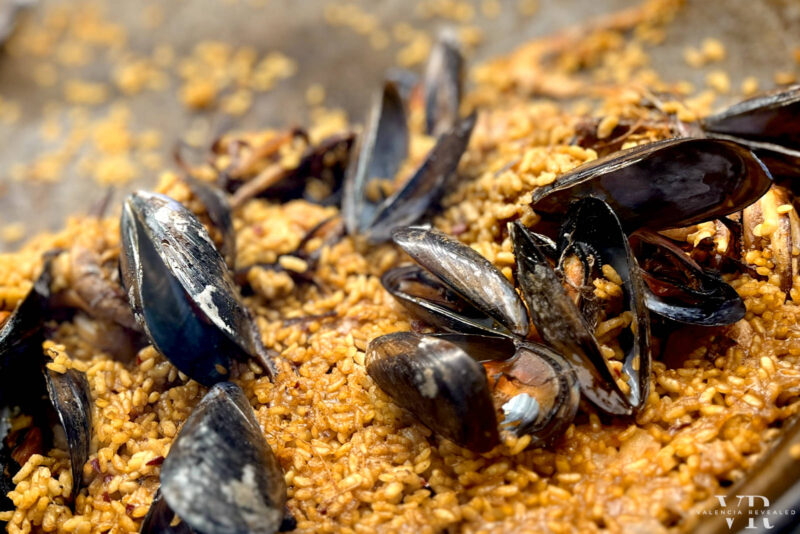
In Spain, you will find a wide variety of opinions about what is paella, ranging from “all rice is paella” to “paella is either paella Valenciana or it’s not paella at all“.
People from different regions of Spain may have strong opinions about what constitutes an authentic paella and might feel that their version best captures the true essence of the dish.
Understandably, you might be caught off guard by just how many Spaniards will fervently argue in favor of one paella definition or the other over the dinner table.
Families often have their cherished recipes and ways of preparing paella, leading to personal biases and debates about the “right” way to make it.
Disagreements can also arise over the choice of ingredients used in paella. Some purists believe that only specific ingredients, such as chicken, rabbit, and specific types of beans, should be used, while others are more flexible.
The discussion is even more intense in Valencia where paella is a reason for regional pride. Some people argue that only the original paella Valenciana recipe should be considered “true” paella.
This is why, whenever a celebrity chef prepares an unconventional paella, Valencianos are very unhappy.
For instance, a few years ago Jamie Oliver broke the internet when he prepared a paella with chorizo (Spanish sausage).
More recently, a 5-star hotel from London suffered the wrath of the Spaniards when they prepared a paella that rather resembled a Chinese three delights rice.
Also, a catering company from Florida garnered attention in Spanish news for preparing decorative paellas with corn and a plethora of other unorthodox ingredients, with no rice in sight.
Ultimately, these discussions, while sometimes passionate, highlight the deep appreciation people have for this iconic Spanish dish. This is understandable, especially in Valencia where paella is an integral part of the locals’ identity.
What types of paella are there?
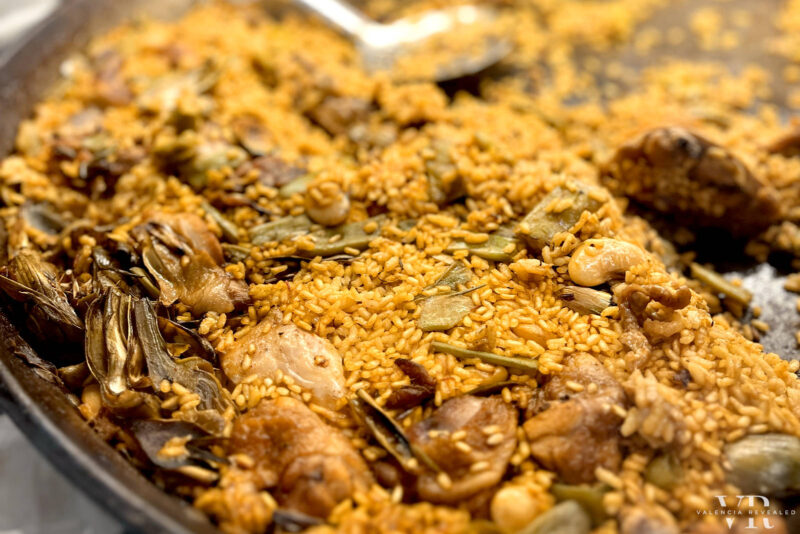
You can find a wide range of paella variations across Spain. This diversity is even more pronounced on a global scale. But the four most widely accepted types of paella are:
- Paella Valenciana: This is the original paella recipe and is considered the most authentic one. It has a protected status and is prepared using a set list of ingredients, such as rabbit, chicken, and green beans.
- Seafood paella (paella de marisco): There is no set ingredient list for this paella version, but it usually features an assortment of seafood like shrimp, mussels, clams, and squid.
- Mixed paella (paella mixta): This is sort of a fusion between paella Valenciana and seafood paella. It uses a mix of seafood, vegetables, and meats such as pork ribs and chicken.
- Vegetable paella (paella de verduras): This paella is made with a variety of vegetables such as green beans, artichokes, asparagus, zucchini, celery, and peppers. The veggies used can vary greatly, depending on the season. This paella recipe doesn’t use animal products, thus it’s suitable for vegetarians and vegans.
Are there other types of paella? Possibly, although whether they should be called paella or not is debatable.
In truth, there are many regional variations of “paella” in Spain, all delicious, even if slightly different. Some would argue that these should be called arroz con cosas (rice with stuff) and not “paella”.
Adding to the confusion, many restaurants use the term “paella” loosely, for a variety of rice dishes to attract clients.
Also read: 12 Best Foods in Valencia And Where to Try Them
So what makes a paella a paella?
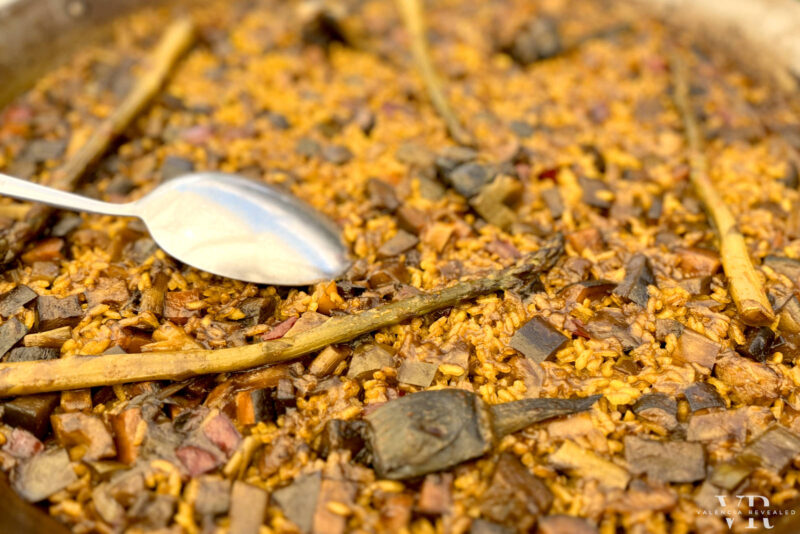
Paella is defined by several key characteristics that collectively distinguish it as a unique dish.
- The pan: Paella is traditionally cooked (and served) in a wide, shallow pan known as a “paella.” As mentioned before, the dish’s name comes from the pan itself.
- The rice: Rice is the essence of paella. For paella to taste like authentic paella, it has to use a short-grain rice variety. This type of rice is capable of absorbing three times the amount of liquid compared to other rice varieties without splitting. As a result, it better retains the flavors of the other ingredients, contributing to the unique texture that characterizes paella. Bomba rice is preferred, but it can successfully be substituted with other short-grain rice varieties.
- The use of saffron: Saffron is a crucial spice in paella, contributing to its vibrant golden-yellow color and distinct aroma. However, saffron can be very expensive (I’ve seen it sold for anything between €3,500 and €10,000 per kilo). Albeit only a tiny amount is used in paella, some restaurants and cooks might substitute it for artificial coloring, which can lead to discussions about authenticity.
- The delicious socarrat: The socarrat is the slightly caramelized layer of rice at the bottom of the pan meant to be scraped with a spoon. Arguably it’s the most important part of paella and the most flavorful one for sure. Achieving the perfect socarrat can be challenging. Different cooking methods can affect the outcome, and debates can arise about the best techniques for achieving it. The socarrat is a hallmark of well-prepared paella.
- The texture: Paella is a dry rice dish with a thin layer of rice. The rice should not be mushy, lumpy, bothy, or starchy. For this to happen, it’s crucial to cook paella over medium heat without stirring.
- The social component: Last but not least, paella is more than a simple dish – it’s a way of bringing people together and an integral part of the Mediterranean diet (declared UNESCO Intangible Cultural Heritage of Humanity). People in Spain often gather around a large paella pan on Sundays and at celebrations. Even when eating out at restaurants, it’s common for the paella pan to be placed in the middle of the table. Individual plates and forks might be offered, but many people prefer to eat the paella straight from the pan with a spoon.
What are the ingredients in a traditional paella Valenciana?
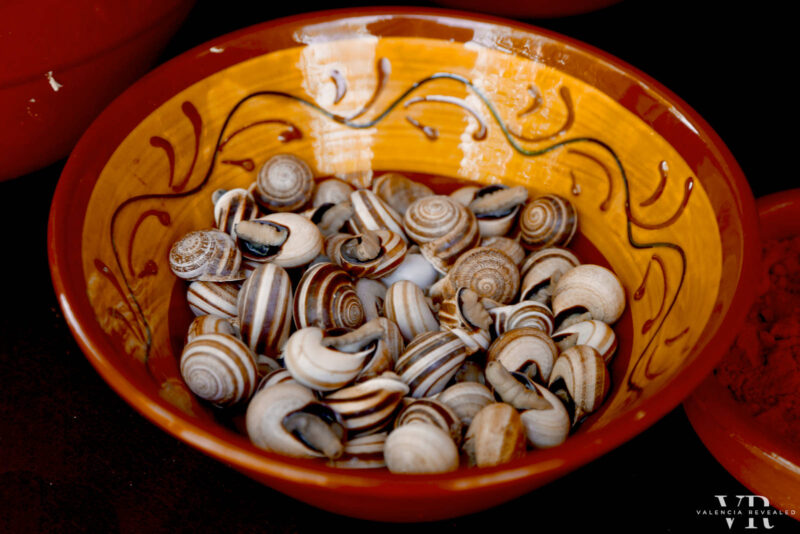
The ingredients that cannot miss from an authentic paella Valenciana are short-grain rice, chicken, rabbit, flat green beans, garrofón (lima beans), tomatoes, saffron, olive oil, salt, and water.
Other ingredients occasionally used in paella Valenciana by some chefs are artichokes, peppers, garlic, duck, rosemary branches, and snails. Yes, snails! Many restaurants in Valencia use snails. But you’ll also find plenty that don’t.
While snails don’t add much flavor, if any at all, if you don’t want them in your paella, you can ask your waiter to leave them out.
A few things to take into consideration when ordering paella
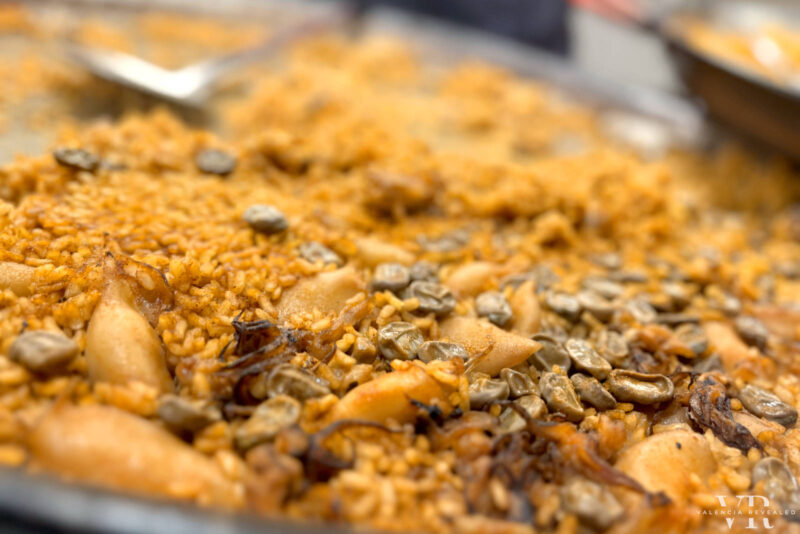
Given the complexities of paella, here are some things to consider when ordering one in Spain.
- Paella is a lunchtime dish. Spaniards consider paella too heavy for dinner, so unless you don’t mind looking like a tourist or going to bed with a stomach full of rice, try to order it for lunch instead.
- Paella is a main course dish. Yet, bars and restaurants sometimes include it on their menú del día (lunchtime special) as a starter. In this case, the chef prepares one big pan of paella enough to feed a couple of dozen people and the waiter serves it by the plate. Is this paella tasty? Likely so. Is this the best version of paella you can eat? Likely not. Why? Because the rice layer is usually too thick and you won’t get to enjoy any socarrat. My advice? Try to eat paella as a main course whenever you can and make sure it’s prepared to order.
- Paella is a rice dish. When eating paella in Spain, especially in Valencia, don’t expect it to be loaded with other ingredients, such as meat, seafood, or vegetables. If you are being served paella topped with so many other things that you can’t even see the rice, then you’re likely in a restaurant catering to tourists and they felt compelled to meet their clients’ expectations rather than capture the soul of the dish. Probably they made other compromises as well, such as not taking the time to allow the socarrat to form at the bottom of the pan and/or replacing the saffron with food coloring. Of course, when preparing paella at home, you can adjust the recipe to your heart’s desire.
Also read: 25 Fun Facts About Paella To Know Before You Order
What does paella pair well with?
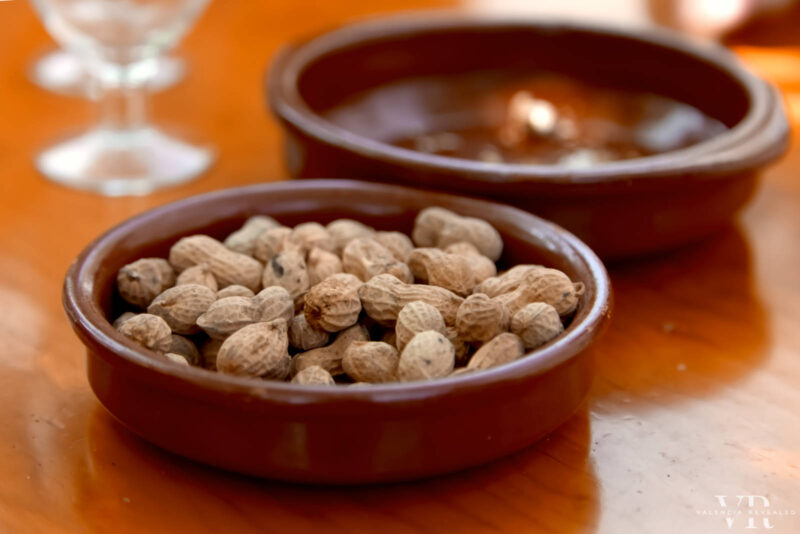
Paella is a stand-alone dish and doesn’t need any accompaniments. However, you can enhance your dining experience by pairing it with a light appetizer.
In Valencia, it’s a common practice to munch on pickled olives, peanuts in shells, fava beans, or lupines while waiting for the paella to be cooked. This typically takes around 40 minutes.
Paella also pairs well with a light salad, a refreshing gazpacho, or a platter of Spanish ham and cheese.
If you want to end your meal on a sweet note, I highly recommend a fresh fruit salad. For something a bit more decadent, you can have fruit tart, sorbet, or ice cream.
Also read: 10 Best Valencian Desserts You Must Try
What beverages go well with paella?
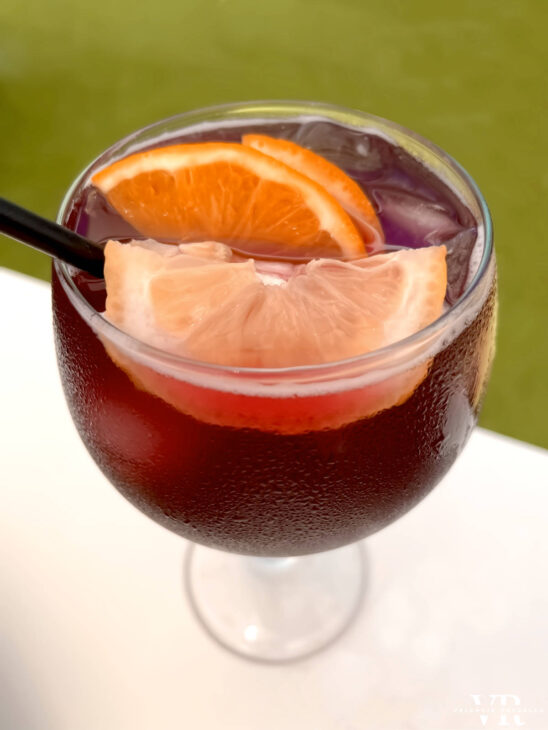
Paella goes well with wine and wine-based drinks as well as beer. I especially like to accompany my paella with tinto de verano, a refreshing cocktail with equal parts red wine and lemon soda.
Another sweet and refreshing option, although slightly more potent, is sangria. Made with red or white wine, fresh fruit, soda, sugar, and a splash of brandy, this concoction captures the essence of summer in Spain.
Coffee, sweet white wine, or anise-flavored liqueur are also great to conclude a paella meal.
Also read: 10 Popular Drinks From Valencia You Must Try
Are there any festivals and events in Spain where paella plays a significant role?
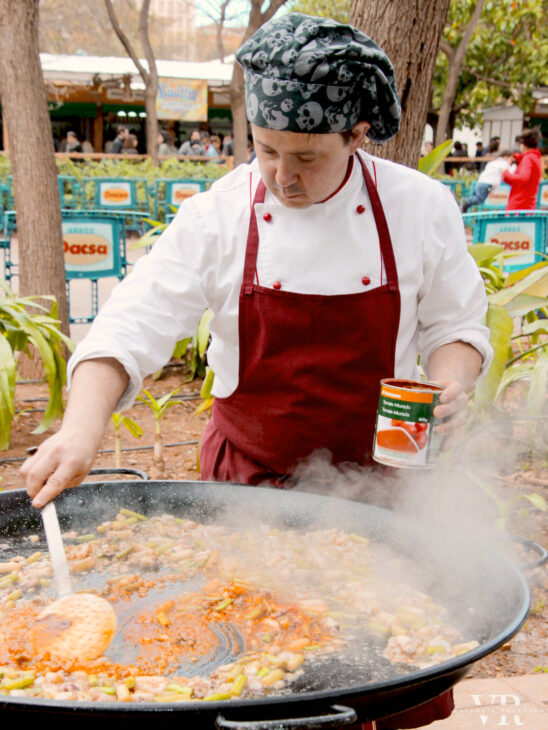
Paella takes the central stage in family gatherings and festivals around Spain, particularly in the Valencia region. Las Fallas and the Sueca International Paella Competition are two of the most notable festivals and events where paella plays a significant role.
Las Fallas de Valencia is the main festival celebrated in the city. It takes place every March and involves building large polyester sculptures and setting them on fire. Throughout the festival, numerous paella cooking contests and giant paellas are organized.
The International Paella Competition takes place in the nearby town of Sueca each September. It involves paella cooking demonstrations and tastings as local and international chefs compete for the best traditional paella Valenciana.
Also read:
Conclusion to what is paella
The question of “What is paella?” is a complex one. That’s because paella is more than a mere dish – it’s a testament to Spain’s culinary heritage and cultural richness.
Evolving from rustic beginnings to a global sensation, paella’s saffron-tinted rice offers a taste of tradition in every bite. So whether you are enjoying it in a restaurant in Spain or in the comfort of your own dining room, paella always tastes better in company.

